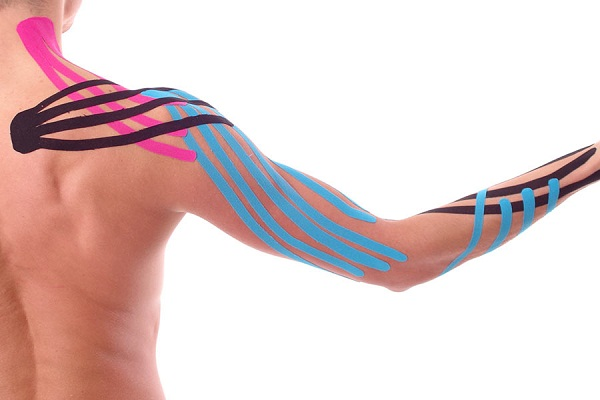KT tape in action
There is no doubt about it….the colorful taping definitely looks cool.
KT tape is an “elastic sports tape designed to relieve pain while supporting muscles, tendons, and ligaments.” It is applied to the skin using various methods, and is primarily used for pain relief however there are also many claims about its benefits including, but limited to the following:
- Providing support to underlying muscles
- Promote lymphatic drainage and decreased swelling
- Decrease pain
- Prevent overstretching or contracting of muscles
- Increase mobility
- Speed recovery
Some people swear by this tape. Some people think it is a hoax. Taping has a long history in medicine from providing external support to ankle sprains, or rough arch support when testing to see if an orthotic device may be beneficial. Those items are not being investigated here. KT tape or other elastic versions have made claims as above, including keeping your kneecaps in alignment or “fixing” a biomechanical issue. Do these hold-up? More importantly, do those alignment “problems” really cause pain. That is a whole other discussion entirely.
Elastic taping has been studied over the years. Some of the studies have shown that there are benefits however, these benefits are usually minor and are not consistently reproduced in the literature. Much of the literature is unclear if the tape provides anything other than a placebo effect. Most of these benefits that are seen are likely due to providing sensory input to the skin as opposed to creating a biomechanical change or fixing alignment. Basically when you put tape on your skin can feel it and you interpret that feeling over the pain that you might be experiencing otherwise. Think of it this way. If hit your funny bone hard it hurts, but if you rub it with your hand it feels a little better. Just simply putting a different sensory input to the skin changes the pain. The tape, after all, is attached to your skin, not to the underlying bones or muscles. The skin slides on the muscles and bones. So to say a tape attached to the skin which can hold a bone in place or support the underlying muscles should come into question just on face value.
Other studies looking at its effect on swelling are also a bit inconclusive. Most of the literature says it could help, but not necessarily on the swelling aspect. More it helps with the discomfort associated with swelling. According to one randomized controlled study looking at swelling in the face/jaw they state that “KT gives patients the impression of a minor swelling detracting them from their pain and morbidity.” While there is no hard evidence supporting a reduction in swelling that is clinically significant, the tape does seem to make a difference to many patients.
Another meta-analyis (examination of all of the data) by Williams, et al. found the following when looking at all available evidence.
“The efficacy of KT in pain relief was trivial given there were no clinically important results. There were inconsistent range-of-motion outcome results, with at least small beneficial results seen in two studies, but trivial results in two other studies across numerous joint measurements. There was a likely beneficial effect for proprioception regarding grip force sense error, but no positive outcome for ankle proprioception. Seven outcomes relating to strength were beneficial, although there were numerous trivial findings for quadriceps and hamstrings peak torque, and grip strength measures. KT had some substantial effects on muscle activity, but it was unclear whether these changes were beneficial or harmful. In conclusion, there was little quality evidence to support the use of KT over other types of elastic taping in the management or prevention of sports injuries. KT may have a small beneficial role in improving strength, range of motion in certain injured cohorts and force sense error compared with other tapes, but further studies are needed to confirm these findings”
So what can we take from all of this evidence? Well, the first would be that some people do benefit from the use of KT tape however, the mechanism isn’t known. Likely any improvements are in the form of altering sensory input to the skin, thereby impacting proprioception (awareness of the position and movement of your body), or placebo effect. If you ask me it is kind of a hit or miss with elastic taping. I think if you are not relying on KT but using it as an adjunct to decrease pain, provide sensory feedback then go ahead. I mean, there is virtually zero risk, aside from skin irritation from the adhesive. It is definitely not a cure-all by any means though. If you are seeing a clinician or trainer and they are selling it as a cure-all it might be a red flag. In fact, there was a class action lawsuit against the company for making such outlandish claims that weren’t backed by research.
In conclusion
Yes, it might have some benefits, although slim and not consistently reproduced in the literature.
No, it will not cure anything, prevent injury or overstretching of muscles, or fix the “alignment” of a bone.
Yes, it might have an impact on muscle strength….but that is a big might
Yes, it looks cool (but the tan lines you might get from it will not look as swanky)
Yes, the multitude of colors that they decided to go with was pure marketing genius

